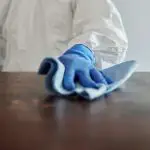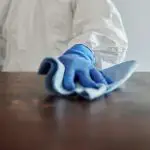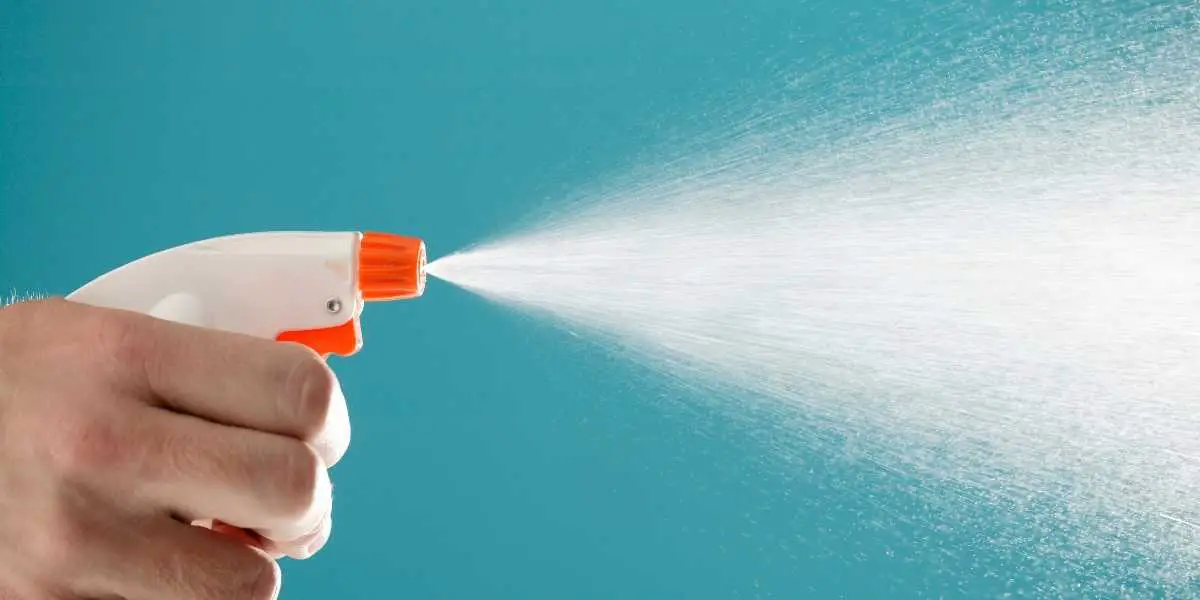Hey there! Did you know that 78% of households in the US use Lysol for disinfecting surfaces? If you're wondering whether Lysol can stain your fabrics, you're in the right place.
Understanding how Lysol interacts with different types of fabric can help you prevent potential staining and keep your fabrics looking fresh and clean. In this guide, we'll explore Lysol's ingredients, how it affects various fabrics, factors that can contribute to staining, and tips for using Lysol on fabrics.
We'll also cover how to remove Lysol stains from fabrics and provide alternative disinfectant options for fabrics. Let's dive in and master the art of keeping our fabrics germ-free without any unwanted stains!
Key Takeaways
- Fabric composition and dye stability are important factors that can contribute to staining when using Lysol on fabrics.
- Conducting patch tests on inconspicuous areas of the fabric can help assess potential impact and prevent staining.
- Prompt and gentle treatment of stains can prevent them from setting into the fabric after contact with Lysol.
- Natural disinfectant alternatives such as white vinegar, hydrogen peroxide, and essential oils can be used to disinfect fabrics without the risk of staining.
Understanding Lysol's Ingredients
You should look up the ingredients in Lysol to understand how they might interact with fabrics. Understanding chemical composition is crucial in determining fabric compatibility. Each fabric has its own set of properties, and certain chemicals in cleaning products can react differently with various fabrics. By knowing the chemical composition of Lysol, you can make an informed decision about using it on different types of fabric.
Lysol contains various chemicals such as ethanol, alkyl, dimethyl benzyl ammonium saccharinate, and others. These chemicals play a significant role in how Lysol interacts with fabrics. For example, ethanol can potentially affect dyes in fabrics, while alkyl dimethyl benzyl ammonium saccharinate is known for its antimicrobial properties, which may impact certain types of fabrics.
Understanding these ingredients helps you anticipate how Lysol may affect your fabrics, allowing you to take necessary precautions. It's essential to check fabric care labels and conduct a patch test in an inconspicuous area before using Lysol on any fabric. This proactive approach can prevent potential damage and ensure fabric longevity.
Testing Lysol on Different Fabrics
Testing Lysol on different fabrics involves conducting patch tests to assess its potential impact on various materials. When testing fabric compatibility with Lysol, it's important to apply a small amount of the product on an inconspicuous area of the fabric. This allows you to observe any adverse reactions without causing significant damage. Once the Lysol application is completed, it's essential to wait for the fabric to dry completely and then check for any discoloration, fading, or changes in texture. Repeat this process on different fabric types to understand how Lysol interacts with each material.
It's crucial to consider the fabric's composition when conducting these tests. Natural fibers such as cotton, wool, and silk may react differently to Lysol compared to synthetic fibers like polyester or nylon. Additionally, different fabric finishes, such as water-resistant or flame-retardant coatings, can also influence the compatibility with Lysol.
Factors That Can Cause Staining
Factors that can contribute to staining include fabric composition, dye stability, and prolonged exposure to Lysol. Different fabrics react differently to cleaning agents, and understanding the composition of the fabric is crucial in determining the best approach for stain removal. For instance, delicate fabrics such as silk or wool may be more prone to staining and damage when exposed to Lysol. Additionally, the stability of the dye used in the fabric can impact its resistance to staining. Fabrics with less stable dyes may be more susceptible to discoloration when in contact with Lysol.
To prevent staining, it's essential to consider fabric care and stain prevention methods. Always check the care label on your fabric to determine the best cleaning approach. When using Lysol or any cleaning product, it's advisable to do a spot test on a small, inconspicuous area of the fabric to ensure it doesn't cause any adverse effects. Additionally, prompt and gentle treatment of stains can help prevent them from setting into the fabric. Always follow the manufacturer's guidelines for stain removal and fabric care to maintain the quality and appearance of your fabrics.
Tips for Using Lysol on Fabrics
When using Lysol on fabrics, always refer to the care label and conduct a spot test to ensure compatibility and prevent potential staining.
To make the most of using Lysol on fabrics, follow these tips:
- Dilute Properly: Always dilute Lysol according to the instructions on the label. Using it at full strength can be too harsh on fabrics and may cause discoloration or damage.
- Spot Treatment: If you need to treat a specific stain, apply the diluted Lysol solution to a clean white cloth and gently dab the stained area. Avoid rubbing, as this can spread the stain or damage the fabric fibers.
- Rinse Thoroughly: After using Lysol on fabrics, be sure to rinse the treated area thoroughly with water. Residual Lysol left on the fabric can lead to discoloration or damage over time.
By following these simple tips, you can effectively use Lysol on fabrics while minimizing the risk of staining or damaging your clothing or household textiles.
Always prioritize fabric care and stain prevention to keep your fabrics looking their best.
Removing Lysol Stains From Fabrics
So you've accidentally gotten Lysol on your favorite fabric, and now you're wondering how to remove the stain.
Don't worry, we've got you covered with some effective tips for removing Lysol stains from fabrics.
From gentle stain removal techniques to preventing future fabric stains, we'll guide you through safe and effective fabric cleaning methods.
Lysol Fabric Stain Removal
You can effectively remove Lysol stains from fabrics using a gentle stain remover and following the care instructions on the fabric label. When dealing with Lysol stains on fabrics, consider the following tips:
- Blot the stained area with a clean cloth to absorb any excess Lysol residue.
- Apply a small amount of gentle stain remover to the stained area and let it sit for a few minutes.
- Gently rub the stained area with a soft-bristled brush or cloth, then launder the fabric as usual following the care instructions.
By following these steps, you can effectively remove Lysol stains from fabrics without causing damage.
It's important to ensure that the fabric disinfection process doesn't compromise the fabric's integrity, maintaining Lysol fabric safety.
Preventing Lysol Fabric Stains
To prevent Lysol fabric stains, start by promptly blotting any spills with a clean cloth to minimize absorption into the fabric. Avoid rubbing the fabric, as this can spread the Lysol and worsen the stain.
Next, rinse the affected area with cold water, taking care not to oversaturate the fabric. Gently dab the area with a clean, damp cloth to remove as much of the Lysol as possible.
If the fabric is machine-washable, promptly launder it according to the care instructions, using an appropriate stain remover if needed.
For non-machine washable fabrics, consider consulting a professional cleaner to address the stain.
Regularly reviewing and following the fabric care instructions for each item can also aid in preventing and minimizing stains.
Proper attention and care can go a long way in stain prevention.
Safe Fabric Cleaning
To effectively remove Lysol stains from fabrics, begin by testing a small, hidden area of the fabric with your chosen cleaning solution to ensure it doesn't cause further damage. Once you have confirmed the safety of the cleaning solution, you can proceed with the following steps to safely remove Lysol stains from your fabrics:
- Gently blot the stain with a clean cloth to absorb any excess Lysol residue.
- Apply a small amount of the chosen cleaning solution to the stained area and gently blot with a clean cloth.
- Rinse the area thoroughly with water and allow it to air dry.
Alternative Disinfectant Options for Fabrics
When disinfecting fabrics, it's important to regularly consider alternative options to avoid potential staining or damage. Fabric disinfectants like Lysol can effectively eliminate germs, but they may not always be the best choice for all types of fabrics due to the risk of staining.
Fortunately, there are several natural alternatives that can disinfect fabrics without causing any harm.
One effective natural alternative is white vinegar, which has antimicrobial properties and can help eliminate germs from fabrics. Simply mix equal parts of water and white vinegar in a spray bottle and mist it onto the fabric. Allow it to sit for a few minutes before washing as usual.
Another option is using hydrogen peroxide, which is a gentle disinfectant that can be sprayed directly onto fabrics and left to air dry.
Additionally, essential oils such as tea tree oil and lavender oil have antifungal and antibacterial properties that make them excellent natural disinfectants. Mix a few drops of your preferred essential oil with water in a spray bottle and lightly mist the fabric before allowing it to air dry.
Frequently Asked Questions
Can Lysol Cause Color Fading on Fabrics Over Time?
Using Lysol on fabrics can cause color fading over time, leading to fabric discoloration. To maintain fabric care, consider spot testing, following best practices, and avoiding prolonged exposure to Lysol to prevent long-term effects.
Will Lysol Leave a Strong Odor on Fabrics After Use?
After using Lysol, its residue can leave a strong odor on fabrics. Consider using fabric softener to help with scent absorption. Be mindful of the potential for lingering smells, especially if you have sensitivities.
Can Lysol Damage Delicate or Vintage Fabrics?
Yes, Lysol can damage delicate or vintage fabrics. It may cause color fading, fabric staining, and isn't compatible with all fabric types. Be cautious to avoid skin contact, and consider alternative cleaning products.
Is It Safe to Use Lysol on Fabrics That Come Into Contact With Skin, Such as Clothing or Bedding?
Yes, Lysol can be safe on fabrics that come into contact with skin. However, it's important to test on a small area first, as it may cause irritation on sensitive skin. Alternatively, consider using disinfectant options specifically designed for fabrics.
Are There Specific Types of Fabrics That Are More Prone to Staining From Lysol?
Certain fabrics, like silk or wool, are more prone to staining from Lysol. To prevent stains, test a small area first and consider using color protection products. For odor control, airing out fabrics is also effective.
- Current Satin Fabric Price in Bangladesh for Garments and Decor - June 21, 2025
- A Guide to Interlock Fabric Manufacturers in Bangladesh - June 21, 2025
- What Caused the Rana Plaza Factory Collapse? An In-Depth Look - June 21, 2025







